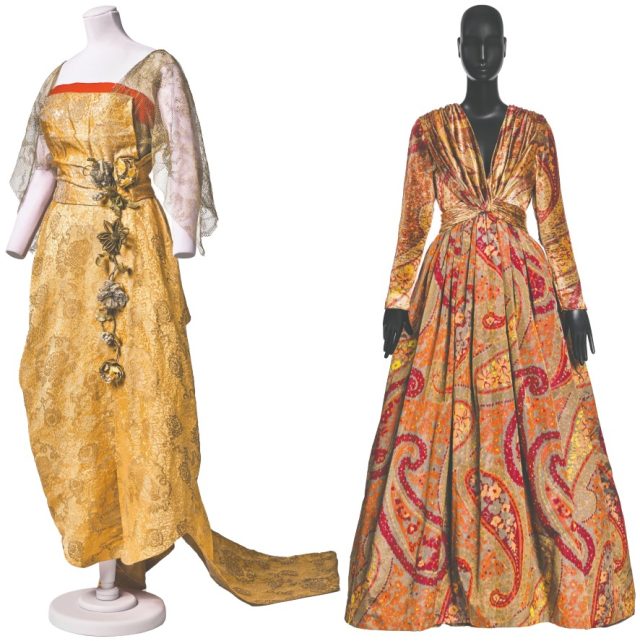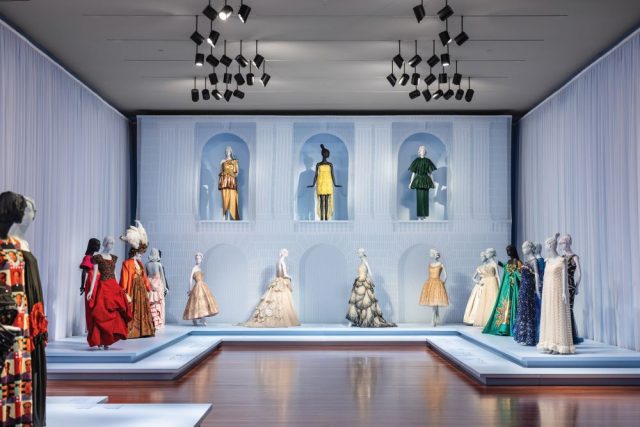From bohemian styles to high-end evening wear, San Francisco’s location on the Pacific Rim combined with its creative, inclusive mindset helped to develop the unique fashion of the Bay Area. “Fashioning San Francisco” examines the role of style and social identity and represents a century of fashion worn by Bay Area women. The exhibition presents the work of more than 50 fashion designers, from Balmain to Miyake, Valentino to McQueen, with the majority of ensembles to be displayed for the first time.
CIVIC, SOCIAL, AND CULTURAL CHANGE
The exhibition begins in the early 20th century, after the 1906 earthquake and fire when the city sought to redefine itself and assert its international status, which manifested in the fashion of its prominent women. Imported French fashions were brought through the port and French couture gowns were presented at the Panama-Pacific International Exposition in 1915. During the 19th and 20th century, the French represented one of the largest immigrant communities in San Francisco, which was eager to import French goods. Early French designs are on display from French designers, including rare Callot Sœurs and Lucile gowns, attesting to the city’s affluence and cosmopolitanism.
THE LITTLE BLACK DRESS TO THE AVANT-GARDE
The continuance of international trade birthed the rise of department stores as importers of European haute couture in the mid-20th century. The San Francisco economy was booming, and iconic department stores cropped up, including I. Magnin, City of Paris, The White House, and Lilli Ann. The nightlife and its related social scene created a demand for clothes that made a statement. The exhibition dedicates a section to the most indispensable piece in a wardrobe, “the little black dress,” featuring elegant black dresses from Christian Dior, Karl Lagerfield, Oscar de la Renta, and others. Always embracing the experimental, San Franciscans also supported more radical designers such as Rei Kawakubo, Issey Miyake, Junya Watanabe, and Yohji Yamamoto.
A mix of materials and styles are represented, including the “power suit,” and Western designers inspired by Asian and African aesthetics along with other international cultures. The exhibition also features a selection of shoes from the Fine Arts Museums’ permanent collection, adding to the mix of materials and styles of San Francisco’s diversity. A Vivienne Westwood evening jacket, a pair of shoes by Sarkis Der Balian, and a Ralph Rucci cape and gown — the exhibition suggests that the so-called “major” fashion cities of Paris, Milan, London, and New York now includes San Francisco.

AUGMENTED REALITY TRY-ON EXPERIENCE
For the first time in a museum setting, an interactive augmented reality installation gives visitors a chance to see how three evening ensembles presented in the exhibition will look on them. The technology company Snap Inc. is collaborating with the museum, bringing fashion to life via virtual reality. The Snapchat augmented reality mirrors are an immersive experience allowing the public to “try on” outfits by the late French designer Yves Saint Laurent, Chinese-American Bay Area-based designer Kaisik Wong, and Italian designer Valentino. The three mirrors transform the museum into a virtual changing room enabling visitors to model these classic ensembles.
LEGACY OF STYLE
“‘Fashioning San Francisco’ situates the museums’ remarkable high fashion and haute couture collections [one of the most extensive in the country] within the context of the city’s development and the ascension of Bay Area women as civic, social, cultural, and sartorial leaders,” said Laura L. Camerlengo, curator in charge of costume and textile arts at the Fine Arts Museums of San Francisco. “These individuals further contributed to the cultural fiber of their communities by donating their wardrobes to the Fine Arts Museum of San Francisco for the preservation and the benefit of future generations. We are delighted to honor and elevate their legacies.”
The exhibition is accompanied by a 200-page exhibition catalogue. A lavish collection of full-color photos and essays explore the city’s position in the world with a special focus on women’s contributions to civic life and how women have shaped this collection.
Fashioning San Francisco: A Century of Style: Tue.–Sun., 9:30 a.m.–5:15 p.m. through Aug. 11, $32, de Young Museum, 50 Hagiwara Tea Garden Dr., 415-750-3600, famsf.org
Sharon Anderson is an artist and writer in Southern California. She can be reached at mindtheimage.com.





